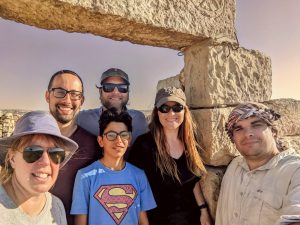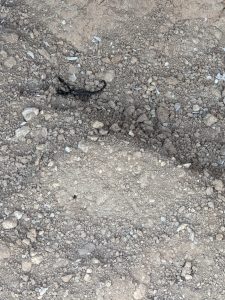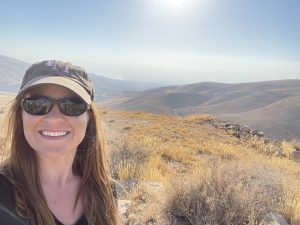
Studying Human Remains in Archaeology
In 2022 I was awarded a grant that allowed me to join the Khirbat al-Mukhayyat Archaeological Project (KMAP) near Madaba, Jordan. This project is directed by Dr. Debra Foran of Wilfred Laurier University in Ontario, Canada. Though I have worked in Egypt for many years, I had only visited Jordan as a tourist. I fell in love with the country and people immediately, and was thrilled that an ASOR grant made it possible for me to join such a wonderful project in Jordan.

The 2022 Khirbat al-Mukhayyat team at the site of the ancient town of Nebo. From left to right: Debra Foran, Andrew Danielson, Mashoor Fshaikat, Greg Braun, the author, and Grant Ginson.
My research mainly centers on human remains, and in Egypt I typically analyze either mummies or commingled (i.e. mixed up) human remains from tombs that were previously excavated. I was very excited to join KMAP and analyze some human remains the team had found inside a shallow cave a few years before. The wadis (valleys) contain numerous caves, and a previous survey found that some of the caves contained human remains. The human remains were mixed up and contained few or no artifacts, and probably date to the Byzantine period. The focus of our work in 2022 was on surveying some of the wadis surrounding the ancient town of Nebo, another project directed by Dr. Foran. Due to the danger of looting, in 2022 the Department of Antiquities in Jordan gave us permission to collect the human remains that were visible in some of the shallow caves.

A scorpion that we discovered on our first day on site.
Sometimes people think that there isn’t much to be gained from studying sites or burials that have been looted or heavily disturbed, but actually a lot of information can still be gained by taking a close look at such sites! Even when individual skeletons get mixed up and disarticulated (i.e. the bones are not connected anatomically anymore because the ligaments and muscles holding them in place during life have decayed), it’s possible to get information about how many people are represented, how old they might have been when they died, and sometimes information about what kinds of disease or infections they suffered during life. You might even be able to tell if the people who were buried together were related!
The study of human remains can be challenging for many reasons. While I was in Jordan, the team and I battled the usual afflictions of archaeology in that part of the world: heat, scorpions, spiders, and even lost luggage. But studying human remains also provides different challenges. Sometimes, you find the remains of young children or infants who died very young, or individuals who might have suffered a great deal during life. These discoveries, in addition to constantly confronting your own mortality as a human being, can make the work mentally as well as physically taxing. But it can also be very rewarding.

The author among the ruins of the ancient town of Nebo. The Dead Sea can be faintly seen in the background.
When you analyze human remains, you learn a lot of information that doesn’t necessarily feature in official records or histories of ancient times: what people ate, what kind of tasks and labor they were doing, what kinds of disease they suffered from, and how they might have died. Bioarchaeology is often concerned with the regular people who made up a population, rather than the rulers and elites who had the resources to make elaborate tombs, temples, or monumental inscriptions. This aspect of bioarchaeology is part of why I love it: I get to shine a light on the lives of regular people, people who otherwise might be forgotten. As much as possible, it’s the job of the bioarchaeologist to restore some level of identity to the people who lived in the past, and use that information to illuminate the lives of people now and in the future.
Working in Jordan for KMAP this year was a wonderful opportunity to learn about some of the individuals who lived in this region during the Byzantine Period, and to learn more about the archaeology, history, and landscape of Jordan. I was thrilled to join this amazing team, and can’t wait to return in the future to continue studying the lives of these individuals who were laid to rest in caves around the region.
Dr. Roselyn Campbell is a bioarchaeologist and archaeologist, primarily specializing in Egyptian archaeology. Her research focuses on evidence of trauma and violence in human remains from the past, as well as the history and antiquity of cancer. She has worked at archaeological sites in Egypt, Peru, Ethiopia, Spain, the western United States, and now Jordan. Dr. Campbell can be found on Twitter @RosesBones.
Read more about the the Town of Nebo Project here or find them on Twitter @NeboArchaeology
American Society of Overseas Research
The James F. Strange Center
209 Commerce Street
Alexandria, VA 22314
E-mail: info@asor.org
© 2023 ASOR
All rights reserved.
Images licensed under a Creative Commons Attribution-NonCommercial-ShareAlike 4.0 International License
COVID-19 Update: Please consider making payments or gifts on our secure Online Portal. Please e-mail info@asor.org if you have questions or need help.